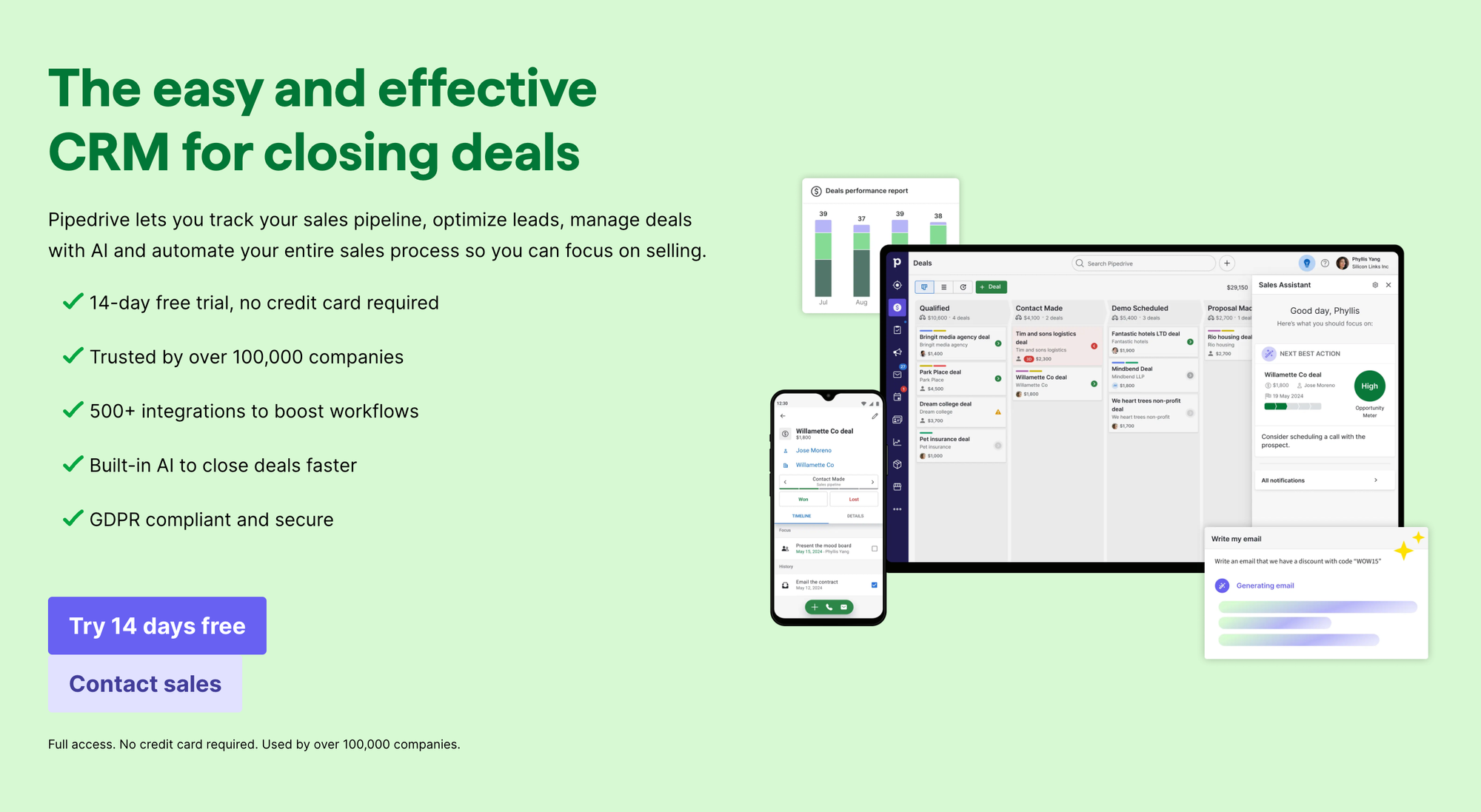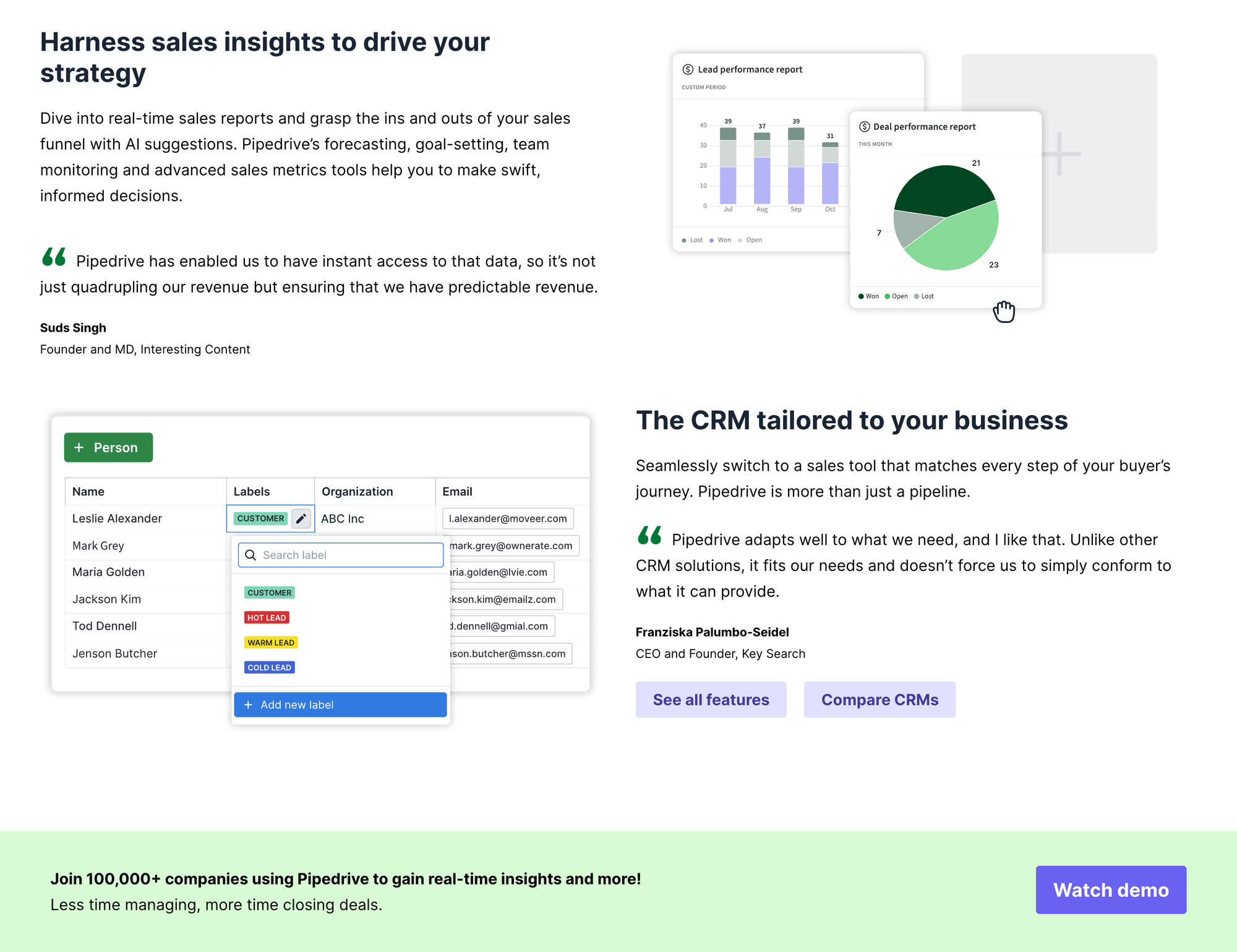HubSpot vs Pipedrive: Which CRM Plays Best with AI Agents?

When small and medium-sized businesses (SMEs) consider integrating AI agents into their daily workflows, the choice of CRM becomes critical. A CRM is no longer just a database of contacts and deals; it is the backbone that supports automated lead qualification, customer engagement, and sales forecasting. Two of the most popular CRMs for SMEs HubSpot and Pipedrive both claim to be AI-ready. But how do they actually compare when paired with AI agents?
HubSpot CRM
All-in-one CRM with marketing automation, forms, chat, and reporting. Ideal for SMBs that want pipeline + campaigns in one place without heavy setup.
- ✓ Predictive lead scoring (Pro+)
- ✓ Visual workflows & email automation
- ✓ Built-in forms, chat, shared inbox

Pipedrive
Intuitive CRM with powerful pipeline automation that streamlines every stage of the sales process. Designed for lean teams that prioritize speed over complexity.
- ✓ Visual pipelines & workflow triggers
- ✓ Fast setup, easy adoption
- ✓ Great for SMB deal flow
In this article, we’ll explore their strengths, weaknesses, and how each CRM performs when AI automation enters the equation.
Before diving deeper, here’s a quick side-by-side of HubSpot vs Pipedrive when paired with AI agents:
Ready to streamline your sales pipeline?
👉 Start your free Pipedrive trial today
CRM Pricing & AI Integration Quick View
| Plan / Feature | HubSpot (Starter) | Pipedrive (Essentials) |
|---|---|---|
| Starting Price | $20/month per user | $14.90/month per user |
| Scalability | Free → $$$ (costs rise fast) | Predictable, tiered pricing |
| Native AI Features | Email gen, lead scoring | Minimal, external AI only |
| AI Agent Integration | Strong API, marketplace support | Clean API, needs middleware |
| Best For | SMEs needing marketing + sales in one | SMEs focused purely on sales & cost efficiency |

Why CRM Choice Matters for AI Agents
AI agents thrive on structured, accessible, and well-integrated data. They need to read from your CRM, trigger workflows, and sometimes even act on behalf of a sales rep. If the CRM can’t provide clean APIs, customizable workflows, or integration flexibility, your AI project will underdeliver.
For SMEs, the stakes are even higher:
- Time savings: AI agents should reduce manual CRM updates.
- Cost control: The CRM should not inflate costs when automation scales.
- Compliance: Data logged by AI agents must align with GDPR and industry standards.
HubSpot Overview
HubSpot is widely seen as the all-in-one CRM for SMEs. Its free tier makes it attractive for startups, while its Marketing and Sales Hubs create a complete ecosystem for customer acquisition and nurturing.
Pros for AI Agent Integration
- Robust API support: HubSpot’s API covers almost every object (contacts, companies, deals, tickets).
- Native AI features: HubSpot already embeds AI-powered email generation and predictive scoring.
- Strong marketplace: Hundreds of AI-related integrations (chatbots, lead enrichment tools).
- Built-in workflows: No-code automation builder that can trigger actions for or from AI agents.
Cons
- Pricing scales quickly: Once you outgrow the free plan, costs jump significantly.
- Data complexity: Larger HubSpot setups can overwhelm SMEs with fields and objects they may not need.
- Vendor lock-in: Migrating out of HubSpot is notoriously challenging.
Pipedrive Overview
Pipedrive is designed with sales teams in mind. It offers simplicity, a pipeline-first view, and strong usability ideal for SMEs that need clarity over complexity.
Boost your deals, close faster, and get full visibility on your sales funnel.
Try Pipedrive now and experience the difference.
Pros for AI Agent Integration
- Lightweight and clean data model: Easy for AI agents to parse and update.
- Affordable: Plans start lower than HubSpot and scale more predictably.
- Custom fields & automations: Flexible enough to integrate AI scoring, enrichment, or outreach.
- Open ecosystem: Webhooks and Zapier/Make integrations are straightforward.
Cons
- Limited native AI features: Pipedrive does not push AI add-ons as strongly as HubSpot.
- Smaller marketplace: Fewer out-of-the-box AI integrations.
- Weaker marketing hub: Focus is primarily sales, requiring external tools for marketing automation.
Your next customer is waiting. Are you ready?
Get started with Pipedrive — no credit card required.

Comparing HubSpot vs Pipedrive with AI Agents
| Feature | HubSpot | Pipedrive |
|---|---|---|
| API & AI-readiness | Extensive API, strong AI integrations | Simple API, good for custom middleware |
| Ease of use | Rich but complex interface | Extremely user-friendly |
| Pricing (SME level) | Free tier but high scaling costs | Predictable and affordable tiers |
| Native AI tools | Built-in AI email, scoring, recommendations | Minimal native AI, relies on external |
| Best for | SMEs ready for an all-in-one system with marketing + sales | SMEs focused purely on sales and cost efficiency |
Which Plays Best with AI Agents?
If your business relies heavily on marketing automation and inbound strategies, HubSpot is the natural choice. AI agents can leverage HubSpot’s ecosystem to manage leads from the moment they hit your website to the point of closing.
If your business is sales-driven and needs simplicity, Pipedrive is more effective. AI agents can handle lead enrichment, qualify prospects, and update pipelines without the overhead of managing marketing features you may not use.
Scalevise’s Perspective
At Scalevise, we’ve implemented both HubSpot and Pipedrive for SMEs with AI agents at the center. Our take:
- HubSpot is best suited for companies scaling quickly and needing marketing + sales under one roof.
- Pipedrive wins for lean teams who want to keep costs under control and maintain focus on pipeline clarity.
Often, we recommend middleware to bridge gaps. For example:
- Using HubSpot but offloading AI enrichment tasks to a custom middleware layer to control costs.
- Using Pipedrive with external AI chat agents for lead qualification.
Practical Next Steps for SMEs
- Audit your sales process
Do you need a strong marketing hub (HubSpot) or just sales pipeline clarity (Pipedrive)? - Map AI agent use cases
Lead qualification, email outreach, or pipeline updates where will agents save the most time? - Calculate total cost of ownership
Don’t just look at CRM license costs. Factor in API calls, AI integrations, and middleware requirements. - Pilot with one workflow
Start with a single AI agent integration, e.g., lead enrichment. Measure the ROI before scaling.

Pipedrive
Intuitive CRM with powerful pipeline automation that streamlines every stage of the sales process. Designed for lean teams that prioritize speed over complexity.
- ✓ Visual pipelines & workflow triggers
- ✓ Fast setup, easy adoption
- ✓ Great for SMB deal flow
Final Thoughts
Both HubSpot and Pipedrive can work with AI agents, but they serve different SME profiles.
- HubSpot is feature-rich but cost-heavy.
- Pipedrive is simple and efficient.
The winning choice depends on your growth model and how deeply you want AI agents embedded into sales and marketing.
👉 Want to see how AI agents can integrate with your CRM? Contact Scalevise for a consult.

